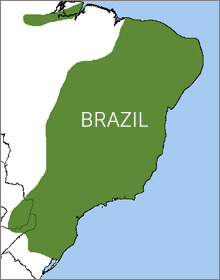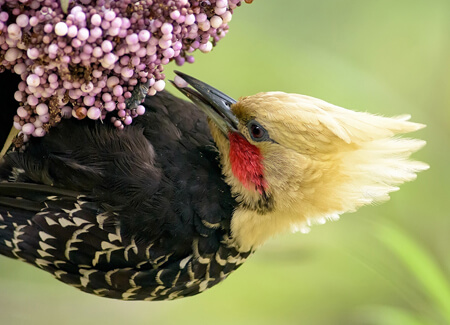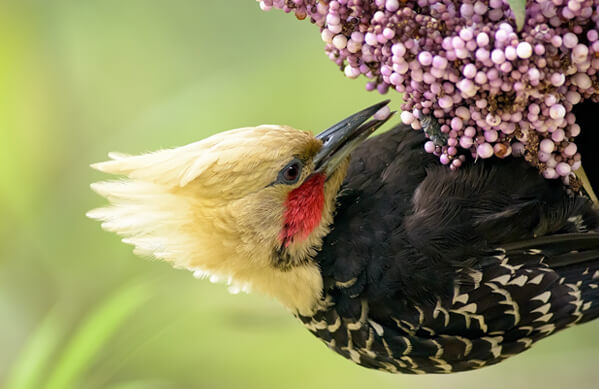 The striking Blond-crested Woodpecker sports a bushy, pointed crest that gives the bird a “big-headed” look. Males also have a bright red malar (cheek) patch.
The striking Blond-crested Woodpecker sports a bushy, pointed crest that gives the bird a “big-headed” look. Males also have a bright red malar (cheek) patch.
Blond-crested Woodpeckers eat fruits and berries, making this bird an important seed disperser. But like other members of the genus Celeus, including the Kaempfer's Woodpecker, the Blond-crested Woodpecker primarily eats tree ants and termites.
Practical Adaptations for Woodpeckers
The Blond-crested Woodpecker is widely distributed throughout eastern Brazil and south into Paraguay and Argentina. It has three recognized subspecies and could possibly be split into more as ornithologists learn more about this poorly studied bird.
Like other woodpeckers, including the tiny Tawny Piculet, the Blond-crested Woodpecker has zygodactyl feet, with two toes facing forward and two back. This foot arrangement, along with specialized central tail feathers that act as props, are practical adaptations that for birds that spends much of their time clambering up and down tree trunks.Pollinators and Predators
Sign up for ABC's eNews to learn how you can help protect birds

Blond-crested Woodpecker male by Jose Carlos Motta, Jr.
Researchers have spotted the Blond-crested Woodpecker sipping nectar from several types of flowering trees. The species appears to be an important pollinator of Spirotheca passifloroides, an endangered canopy tree of Brazil's Atlantic forest. The trees bloom in the austral winter, with small, red flowers that provide large amounts of nectar relished by the birds.
In another fascinating behavior, Blond-crested Woodpeckers often make their nests near the nests of arboreal ants—the same ants that make up a large part of their diet. Apparently the proximity of the ants deters potential predators, providing some protection to the helpless woodpecker hatchlings. The woodpeckers and ants seem to be able to co-exist peacefully, at least for the duration of the nesting season.
Birding for Blond-crested Woodpeckers
The Blond-crested Woodpecker can be sighted at the Oasis Araripe Reserve, which helps to protect the critically endangered Araripe Manakin, as well as the Guapi Assu Ecological Reserve, operated by ABC partner Reserva Ecológica de Guapiaçu (REGUA). Both reserves protect important Atlantic Forest habitat, a rapidly disappearing biome in eastern Brazil. More than 430 bird species have been recorded at Guapi Assu, including Ornate Hawk-Eagle, Green-headed Tanager, and more than 60 other bird species found only in Brazil.
Oasis Araripe and Guapi Assu is part of the Conservation Birding network, which includes more than 70 reserves created and supported by ABC and more than 30 partner organizations throughout Latin American and the Caribbean.
The reserve network has been a model for sustainable bird tourism, attracting well over 25,000 visitors, whose entrance and accommodation fees have helped to finance reserve management and protection.
Donate to support ABC's conservation mission!



















































